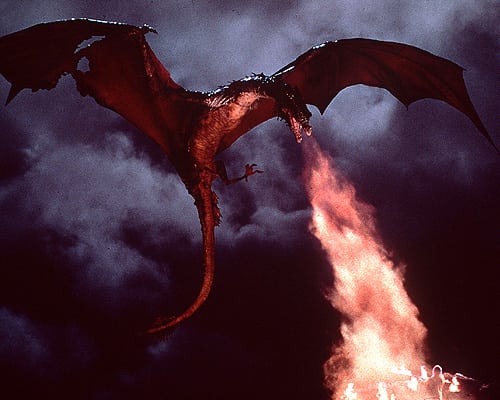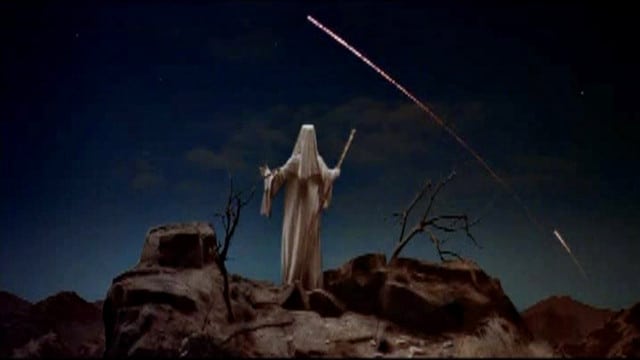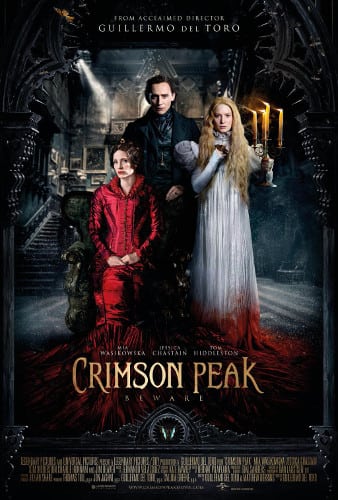Directed by: Matthew Robbins
Written by: Hal Barwood
Starring: Caitlin Clarke, John Hallam, Peter MacNicol, Ralph Richardson
HCF REWIND NO. 186: DRAGONSLAYER [1981]
AVAILABLE ON DVD
RUNNING TIME: 104 min
REVIEWED BY: Dr Lenera, Official HCF Critic
A sixth-century post-Roman kingdom called Urland is being terrorized by a 400 year old dragon named Vermithrax Pejorative. To appease the dragon, King Casiodorus offers it virgin girls selected by lottery twice a year. An expedition led by a young man called Valerian seeks the last sorcerer, Ulrich of Craggenmoor, but Ulrich is killed when he foolishly invites a soldier to stab him to prove his magic powers. His young apprentice Galen Bradwarden inherits the wizard’s magical amulet, and takes it upon himself to journey to Urland, along the way discovering that Valerian is really a young woman, who disguised herself to avoid being selected in the lottery….
Smaug The Magnificent has been highly praised by many who claim it as the best dragon in cinema, and he’s certainly impressive, a rare example in which the CGI in the second Hobbit film worked wonders, though I couldn’t take it seriously because it reminded me far too much of the dragon in Shrek. The creatures have populated live-action and animated films for decades, and I’m very fond of the ones in Sleeping Beauty, The 7th Voyage Of Sinbad and others, but if you were to ask me what is the best dragon in film, I would immediately answer the one in Dragonslayer. The film is one of the highpoints of the early 80’s sword and sorcery boom which fizzled out rather quickly, perhaps partially because back then such material seemed more the province of Dungeons and Dragons-playing geeks [I plead guilty] than anything else and was not generally considered cool at all. It wouldn’t be a third of the movie it is though without its dragon, the real star of the piece. Its design is striking [no four legs here, for a start[, it’s scary yet somewhat majestic, a little bit tragic like most of the great monsters are, it’s superbly executed through the art of Go-Motion, and, while constantly playing a major part in the story, its full appearance is brilliantly built up to in what is a masterclass in how to use a film’s monster and tantalise the audience.
So what is Go-Motion? You’ve probably encountered on this website many reviews from me of films from the legendary and recently departed Ray Harryhausen, whose wonderful creatures dominate pictures like Jason And The Argonauts. The technique was done by shooting a frame of a model, then moving it slightly and shooting another frame. This gave the illusion of movement, and even to this day adds an amazing, almost dream-like sense of unreality to the creatures, but Go-Motion, the creation of Phil Tippett who introduced it into The Empire Strikes Back, went one better, at least in terms of reality, by bringing in something Stop-Motion, because of its nature lacks – motion blur. The animated model was moved slightly during the exposure of each film frame, producing a realistic motion blur rather than the staccato effect brought about by photographing stills. Dragonslayer was the first film to employ this technique in a big way. The script by Hal Barwood and director Matthew Robins borrowed heavily from well-known legends such as St. George And The Dragon, though supposedly they were initially inspired by The Sorcerer’s Apprentice sequence from Fantasia, while setting the story in a very realistic Dark Ages, just after the Romans had left Britain. It was actually a co-production between Disney and Paramount in a time when Disney were experimenting with stranger and darker material, though the results were all commercial failures, and so was Dragonslayer which, I suppose, may seem like a children’s film but isn’t actually kid’s stuff at all.
In truth, the script is a mixed bag, if generally leaning more on the good side than the bad. For a start you have to admire a film which kills off one of its major characters twice. You’ll be able to tell right from the first scene, where the wizard Ulrich thinks he’s nearing his death and asks where all his magic has got it, as well as talking of how the dragon Vermithrax Pejorative is so old he’s actually in pain which is what makes him cause death and destruction, that this is a rather more sophisticated film from the likes of The Beastmaster. The often brooding characters with shrouded motivations [I have a feeling that this film would have done much better at the box office if it were made and released now] are very believable. Sometimes we are asked to feel conflicting emotions in a surprisingly complex way, like when our hero sets about slaying the dragon’s brood, who are seen feasting on a human victim, causing terrible sadness to Vermithrax in a rather affecting scene just after. Sometimes the clichés are subverted, like the role of the Princess who ends up playing a very different part in the tale from the norm. However, attempts at a contemporary slant jar a bit with the realistic feel, some Star Wars borrowings are very obvious, and, while it’s interesting to have a hero who is not a muscular sword swinging fighter, this means that he’s not given much action to do until he goes to slay his dragon. It also doesn’t help that Peter MacNicol is a very uncharismatic here, which may explain why the actor doesn’t list this film on his resume, despite it being the best picture he appeared in after Sophie’s Choice.
Near the beginning, we see a woman being sacrificed to Vermithrax, and the scene is a like a horror film as the music builds and the editing gets faster, but all we see is some steam, a claw and a back shot of the monster’s head. This movie really holds off on showing its monstrous star, and a scene later is handled similarly, except that we see a quick shot of the dragon’s terrifying face before he blasts his victim into ashes [a memorable cameo from Ian McDiarmid as a priest] in a startling shot that amazingly stayed in the UK print of the film. What didn’t stay in were shots of the baby dragons chomping down on a victim – you even get to see a foot being bitten off – so the US DVD is the one to get if you’re interested in this film, though it still remains quite an uncompromising picture that doesn’t at all pander to the usual Disney sensibilities. The babies are quite scary and not at all cute, and it’s around an hour in when we finally see Vermithrax in all his glory, rising up out of the water slowly behind Galen in another moment that really is quite frightening, and somehow they even manage to make Vermithrax seem ancient in his immensely detailed facial features. Including a hydraulic 40 foot model, 16 dragon puppets were used for Vermithrax, each one made for flying, crawling and breathing fire.
Effects-wise the film sometimes shows it age in some poor blue-screen rendering, especially in the big climactic action scenes. Many fans of the film want this corrected and I agree with this. I often hate it when films are tampered with, but something like this is justifiable I think – you weren’t meant to see the matte lines after all. Another example is those darn wires in the 1953 The War Of The Worlds. They could easily remove them. Removing some of the ‘joins’ from shots are the only really successful alterations George Lucas did to the Star Wars pictures in my opinion – if only he’d left everything else alone. Dragonslayer actually looks fabulous most of the time, cinematographer Derek Vanlint giving almost every scene a striking look to it. It’s proof that a film can go for the gritty, muddy approach and yet still be visually very appealing, something which far too many films at the moment don’t seem to bother trying to do. Watching it again, I lost count of the number of times sunlight gloriously streamed in to darkened rooms, or the amount of variety that was done with the basic colours of green and brown in the outdoor scenes [mostly shot in Wales] and yet you really feel like you are in this world, a world where Christianity is gradually encroaching on Paganism and in the process driving out magic and, perhaps, wonder. This is a major theme of many of the great fantasy tales including those about King Arthur, and it’s present here, helping to give the occasionally second-hand story some weight and depth.
Ralph Richardson is for me an even better screen wizard than Ian McKellen and seems to have influenced the latter’s performance for Peter Jackson. He has a marvellous glint in his eye and really gives the impression that he comes from a race of ancient, magical beings. Caitlin Clarke is an interesting heroine, quite unconventional yet still very appealing. Alex North’s very loud score is as aggressive and in-your-face as can be, and, while it’s not at all melodic, it gives a great impression of primitivism. Some of it actually came from the composer’s un-used score for 2001: A Space Odyssey. You’d never get such a complex, dissonant musical score in a would-be blockbuster film today. For me, Dragonslayer, a film I wasn’t too keen on the first time I saw it [not enough action] gets better every time I see it, a strong journey into the heart of superstition and folklore that has more depth than is at first apparent….and the best movie dragon ever!
Rating: 















Be the first to comment